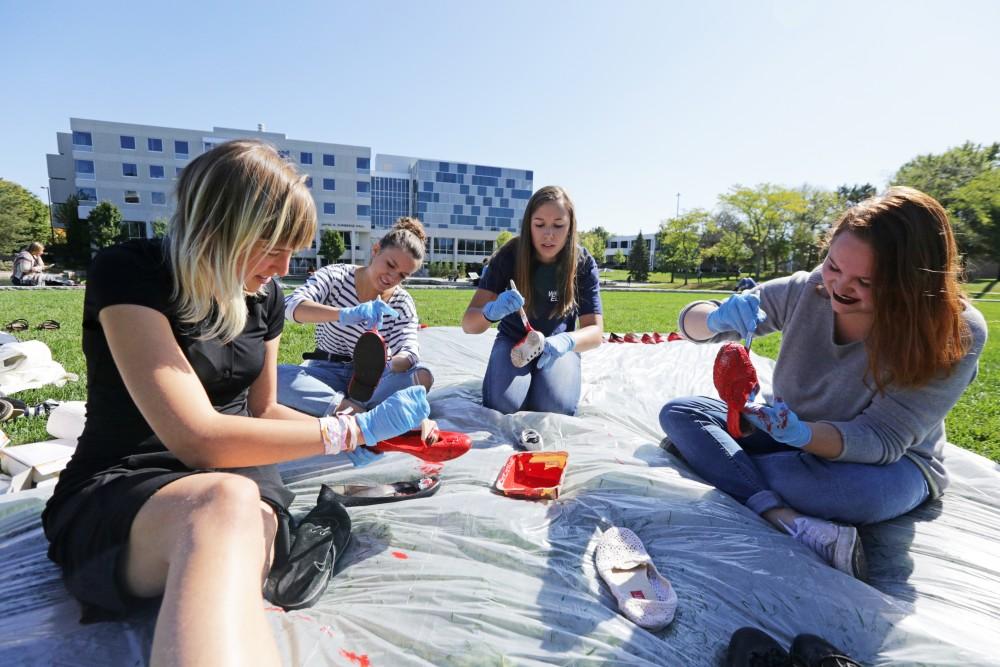Red Shoes Project brings awareness to gendered violence

GVL / Emily Frye Students help paint shoes for the Red Shoes Project art installation on Thursday October 5, 2017.
Oct 19, 2017
It is a harrowing truth that human trafficking and other forms of gendered violence are still occurring in the world. To bring awareness to this, Spanish professor Zulema Moret, in conjunction with several Grand Valley State University departments and community organizations, has brought the “Red Shoes Project” to GVSU.
The Red Shoes Project is an art installation that started in Mexico and has since spanned the world. Shoes are collected, painted red and installed in a public space where the project has the opportunity to garner a lot of attention. GVSU’s version of the installation will be located at the Pew Campus and is set to take place Saturday, Oct. 21, from 11 a.m. to 6 p.m.
“In 2009, Elena Chauvet installed 33 pairs of shoes at the border because around that time, approximately 500 women were killed in the area,” said Moret, who spearheaded bringing the project to campus. “After that installation was finished, she repeated the project in different cities.”
Moret said the interest in the project began for her while she was doing a research project.
“I was doing research for my sabbatical, writing about the role of memory in different artifacts, art, artistic representations,” Moret said. “Then I discovered that project, and I have written articles on four different projects of art in South America, and as I am teaching a new course on art in Latin America, and I like to share projects with my students, and I thought, ‘Well, why not do this project with my class and perhaps the artist would like to come?'”
Other people involved with the GVSU version of the Red Shoes Project said the public installation may bring awareness, empathy and anger to the topic of gendered violence.
“It is easy in the contemporary moment to understand ourselves in Balkanized and binary terms; I think this work will help in exercising both empathy and outrage,” said Anna Campbell, an associate professor in the GVSU art department. “I hope that it influences the GVSU community to continue to take steps towards policies and cultural norms on campus in which our identities as ethical, global and engaged citizens are put into practice.”
A major aspect of the project comes before the installation in the form of painting the donated shoes red.
“The symbol of the shoes is important and why we paint them red,” Moret said. “Previously, part of the artist’s contract said we need to paint in a community, because talking with other people and sharing with other people about why we’re here is the point of the project; it raises awareness.”
Moreover, Campbell said having the installation completed will create a stark contrast with the fun environment of collecting and painting the shoes.
“When we install the shoes, there will be an almost imperceptible transition from the shoes being the generous donations of people in the community to being symbols and stand-ins for people who have been the victims of femicide and trafficking,” Campbell said. “I think it will be a very solemn transition.”
In Campbell’s opinion, taking part in the installation gives students firsthand experience with classroom curricula.
“I am teaching ART 395: ‘Space Studio,’ which is a class that explores installation and site-specific art,” Campbell said. “We are currently studying the politics of monuments and memorials and making 3D digital renderings that engage or intervene in actual monuments, as well as generating renderings that propose entirely new memorials.
“Participating as a class in the Zapatos Rojos, or the Red Shoes Project, is a natural extension of this study, helping to generate the public memorials that best honor our community.”
After the installation is completed, film screenings, discussions and panels will be held at various dates and times.
“Probably after the installation, I think, people will want to ask questions or talk,” Moret said. “Also, I think people will come forward and say, ‘I need help.’”























